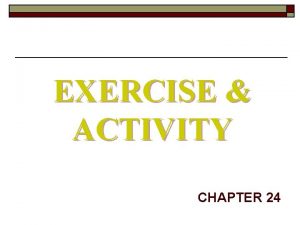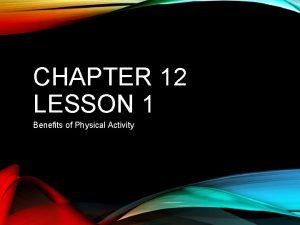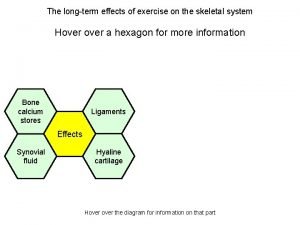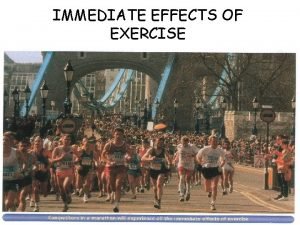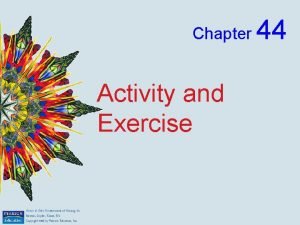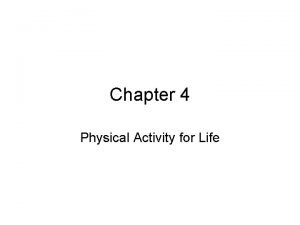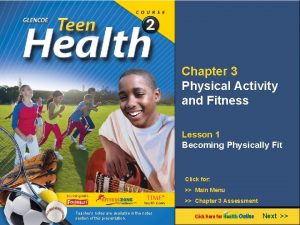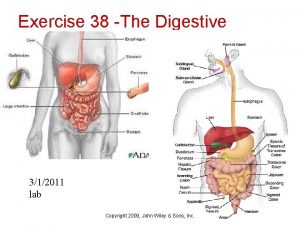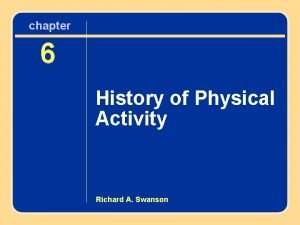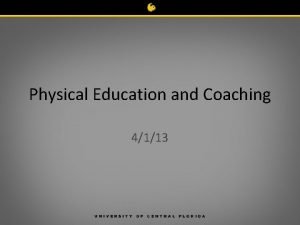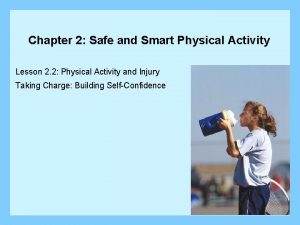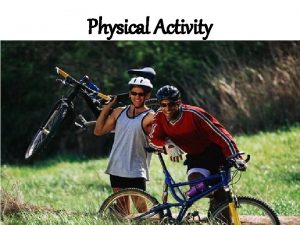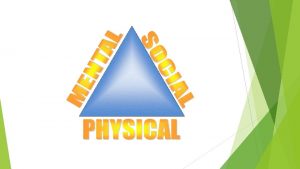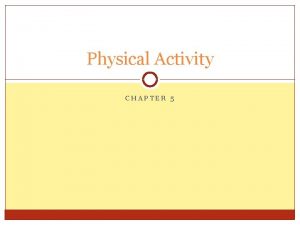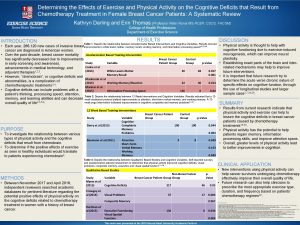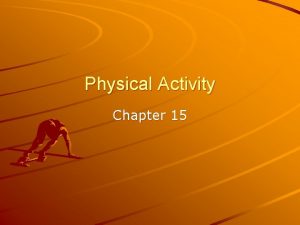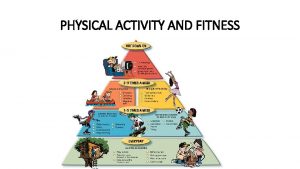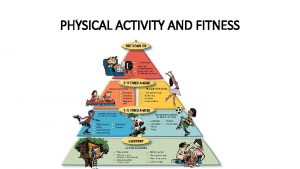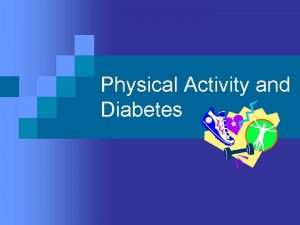Chapter 3 Effects of physical activity and exercise




















- Slides: 20

Chapter 3 Effects of physical activity and exercise on body systems

Effects physical activity and exercise on body systems • Physical activity and exercise have many positive effects on body systems. • Many of that major changes that occur during exercise are to do with body systems.

Systems of the Human Body • • • Cardiovascular system Digestive system Musculoskeletal system Respiratory system Metabolic system Urinary system Integumentary system Lymphatic system Immune system Endocrine system

Cardiovascular System • The heart rate increases and also increases blood flow to supply your muscles with nutrients and oxygen. • Arterial (systolic) blood pressure increase during dynamic exercise. • Cardiac output (the amount of blood pumped by the heart) increase due to the redirection of the blood flow. • Exercise can increase cardiac output to 22 L/min for the average person. Normal cardiac output is 5 to 7 L/min (Kozier, Erb, Blais & Nilkinson, 1995) • Good cholesterol and high-density lipoprotien (HDL) is raised but the dreaded triglycerides is reduced.

Digestive system • Physical activity helps to breaks down food into protein, vitamins, minerals, carbohydrates, and fats, which the body needs for energy, growth, and repair. • Exercise helps to regulate the digestive processes by getting the intestinal muscles working through moving contents more efficiently through the colon (Robertson, 2012). • Exercise improves the appetite and increases the gastrointestinal tract tone. • Improves digestion and elimination of wastes.

Studies by Campbell, 1928 • Exercise of moderate intensity, such as slowly running for 1 -2 miles, inhibited both secretion of gastric juice and the rate of gastric emptying of its contents. • Lighter exercise, such as walking, did not change the rate of gastric excretion and actually appeared to enhance the rate of emptying into the stomach.

Musculoskeletal system • Movement is what keeps the cartilage surrounding bones from drying out by assisting joints in producing synovial fluid. The production of this substance keeps joints well oiled, resistant to friction and makes them supple. This, combined with exercise induced improvements in suppleness of ligaments, and contributes to an improved joint range of motion. • Exercise encourages the production of new bones making bones stronger and denser which can prevent osteoporosis and fractures as people age (Robertson, 2012).

Musculoskeletal system • The size, shape, tone, and strength of muscles, including the heart muscle, are maintained with mild exercise and increased with strenuous exercise. • Strenuous exercise, muscles hypertrophy (enlarge), and the efficiency of muscular contraction increases. • Exercise also helps maintain joint mobility.

Musculoskeletal system • The most common way skeletal muscle is expanded and contracted to promote the processes of the lymphatic system is through natural body movement. • Muscle contraction promotes the flow of lymph to various lymph nodes throughout the body. Lymph flow increases by approximately 2 -to 3 -fold while exercising (Robertson, 2012).

Respiratory system • Pulmonary ventilation increases, largely through stimulation of the respiratory centers in the brain stem from the motor cortex to bring more oxygen to the alveoli. • During strenuous exercise, the intake of oxygen increases to as much as 20 times the normal intake (Guyton, 1991). Normal ventilation is about 5 or 6 L/min. • This improves diaphragmatic excursion. • When exercising, it is always best to breathe IN through the nose and OUT through the mouth. Lung capacity is increased by deep breathing with slow

Metabolic system • Exercise improves the metabolic rate. • The production of body heat and waste product is increased. • During strenuous exercise, the metabolic rate can increase to as much as 20 times the normal rate. • Exercise increases the use of triglycerides and fatty acids.

Urinary system • Promotes efficient blood flow to the kidneys causing the body to excrete wastes more effectively • Prevents stasis (stagnation) of urine in the bladder • During exercise, the kidneys conserve sodium and reabsorb water to maintain fluid balance, which contributes to the reduction in urine production.

Urinary system during heavy exercise • The rise in body temperature causes increased sweating and respiratory loss of water, which intensify kidney changes. • There is a great reduction in renal blood flow, and a slight alteration in the filtration rate of the kidneys. • The reduction of renal blood flow is progressive for at least 30 minutes after the start of exercise and is directly related to the severity of the exercise. (Chapman, 1948) • There is evidence that heavy exercise has certain effects on the function of kidneys.

Integumentary system • Exercise promotes the delivery of nutrients and oxygen and the removal of waste products. • Exercise improves blood circulation to the hands and feet which ultimately results in strong, long, shining hair and nails, and a sparkling complexion. • Exercise makes skin flush with heat and wet with sweat.

Lymphatic System • Muscle contraction promotes the flow of lymph to various lymph nodes throughout the body. • Lymph flow increases by approximately 2 - to 3 -fold while exercising.

Immune system • Moderate exercise reduces levels of stress hormones and other chemicals that suppress the immune system function. • Moderate exercise increases inflammatory activity.

Endocrine system • Exercise affects nearly all of the dozens of hormones the body produces. Two of these substances, epinephrine and norepinephrine, are key players in promoting physical changes during exercising. Norepinephrine also regulates moods. • Blood insulin levels begin decreasing after 10 minutes of aerobic exercise. • The pituitary gland releases human growth hormones. • The thyroid gland sends out hormones that regulate the body’s temperature, heart rate and blood pressure.

Psychoneurological system • Increases self-confidence • Reduces mental fatigue • Contributes to a positive self-concept

Psychoneurological system • Exercising regularly will promote the growth of new brain cells. These new brain cells help boost the memory and learning. • Exercise is one of the most effective prevention and treatment strategies for depression. • Exercise improves sleep.

Psychoneurological system • Exercise can stimulate the production of endorphins. Endorphins are chemical substances produced by the brain, pituitary glands, and other bodily tissues. • Endorphins can help reduce tension and anxiety.
 Physical activity and physical fitness assessments grade 9
Physical activity and physical fitness assessments grade 9 Chapter 24 exercise and activity
Chapter 24 exercise and activity Fitness chapter 12
Fitness chapter 12 Chapter 12 lesson 2 improving your fitness
Chapter 12 lesson 2 improving your fitness Long term effects of exercise on skeletal system
Long term effects of exercise on skeletal system Immediate effects of exercise
Immediate effects of exercise Activity and exercise fundamentals of nursing
Activity and exercise fundamentals of nursing Physiological activity
Physiological activity Chapter 4 physical activity for life answers
Chapter 4 physical activity for life answers Chapter 12 lesson 3 planning a personal activity program
Chapter 12 lesson 3 planning a personal activity program Fitness chapter 3
Fitness chapter 3 Exercise 38 review sheet art-labeling activity 1 (1 of 2)
Exercise 38 review sheet art-labeling activity 1 (1 of 2) Activity coefficient
Activity coefficient Who global strategy on diet, physical activity and health
Who global strategy on diet, physical activity and health Ocr level 3 sport
Ocr level 3 sport Between 1950 and 2000, physical activity professions
Between 1950 and 2000, physical activity professions Physical activity and sport pedagogy definition
Physical activity and sport pedagogy definition Physical activity and nutrition coordinator
Physical activity and nutrition coordinator Safe and smart physical activity
Safe and smart physical activity Chapter 2 classroom activity 2-2
Chapter 2 classroom activity 2-2 Physical and chemical properties sorting activity
Physical and chemical properties sorting activity

